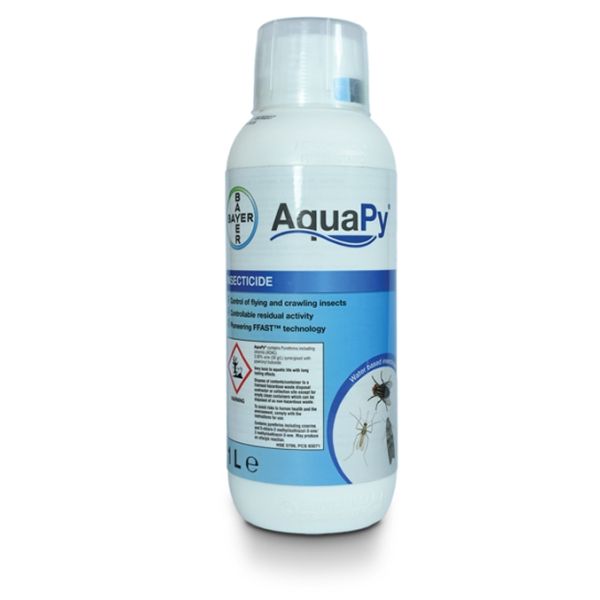Aquapy 1Ltr

Please sign-in to view pricing and order products.
AquaPy can be used for the fast flushout, rapid knockdown and control of a range of flying and crawling insects.
Active Ingredient: Natural Pyrethrin 3% Application: Compression sprayer or fogging/ULV
Key Features and Benefits:
- Control of flying and crawling insects
- Controllable residual activity
- Pioneering FFAST™ technology
- Low volume: 100ml treats 3000m³
*** PROFESSIONAL USE ONLY ***
It is a virtually odourless, non flammable, water based insecticide which contains natural pyrethrum, synergised with piperonyl butoxide. This combination gives it the flexibility in where and how it can be used; ready-to-use for application as an ultra low volume aerosol or can be diluted with water for application as a mist, thermal fog or surface spray. AquaPy is also accepted for use in certified organic premises and has the ability to be applied as a space spray (ULV aerosol, Mist/Thermal Fog) or as surface spray depending on the situation and target pest.
AquaPy contains Chrysanthemum cinerariaefolium extract 0.37% w/w (3g/l), piperonyl butoxide and Distillates (petroleum), hydrotreated light. (HSE 5799). USE BIOCIDES SAFELY. ALWAYS READ THE LABEL AND PRODUCT INFORMATION BEFORE USE. PAY ATTENTION TO THE RISK INDICATIONS AND FOLLOW THE SAFETY PRECAUTIONS ON THE LABEL.
Active substance Chrysanthemum cinerariaefolium previously called Pyrethrin.
HSE 5799
Dilution and Application Rates
| Treatment | Pest Species | Dilution Rate with Water | Application Rate |
| Space Spray Indoors | AquaPy® Water | ||
| Ultra Low Volume Aerosol |
Flying Insects (not Tobacco Beetles) Crawling Insects Cockroaches Stored Product Insects and Tobacco |
Undiluted – Ready to Use Undiluted – Ready to Use Undiluted – Ready to Use Undiluted – Ready to Use |
100 ml/3000 m³ 200 ml/3000 m³ 300 ml/3000 m³ 400 ml/3000 m³ |
| Misting/Thermal fogging | Flying Insects (not Tobacco Beetles) | 1 part (100 ml) 9 parts (900 ml) | 1 Litre/3000 m³ |
| Misting |
Crawling Insects Cockroaches Stored Product Insects and Tobacco |
1 part (200 ml) 4 parts (800 ml) 1 part (300 ml) 2.3 parts (700 ml) 1 part (400 ml) 1.5 parts (600 ml) |
1 Litre/3000 m³ 1 Litre/3000 m³ 1 Litre/3000 m³ |
| Space Spray Outdoors | |||
| Ultra Low Volume Aerosol |
Large Areas Small Areas |
Undiluted – Ready to Use Undiluted – Ready to Use |
500 ml/Hectare 100 ml/500 m² |
| Thermal fog |
Large Areas Small Areas |
1 part (100 ml) 9 parts (900 ml) 1 part (80 ml) 11.5 parts (920 ml) |
5 Litres/Hectare 1 Litre/500 m² |
| Surface spray | |||
| Effective up to 24 hours | Cockroaches Fleas & Bed Bugs | 1 part (125 ml) 39 parts (4.875 L) | 5 Litres/100 m² |
| Effective 1 to 2 weeks |
Wasps (Nests) |
1 part (500 ml) 9 parts (4.500 L) 1 part (100 ml) 9 parts (900 ml) |
5 Litres/100 m² Spot Application |
| Solid waste management | Flies | 1 part (100 ml) 9 parts (900 ml) | 5 Litres/100 m² |
Application rates and delivery
As a Space Spray Indoors
Close doors and windows and shut off ventilation systems before spraying and for at least 30 minutes after treatment. Distribute spray evenly throughout the area. Treatments should be timed to coincide with the time of maximum flight activity for the target insect. For Tobacco Beetles this will typically be in the late afternoon and evening. Direct the spray into identified insect harbourages. Spray as frequently as the situation demands. Treatment at weekly intervals is recommended. More frequent applications may be necessary for heavy infestations.
As a Space Spray Outdoors
In general the dose rate for large areas should be acceptable (see table), but if only small areas are being treated the dose rate may have to be increased. The best conditions for outdoor spraying occur in the early morning or late afternoon and evening when conditions are most likely to be still.
As a Surface Spray
As a direct contact spray apply at a rate sufficient to dampen the insects present on the fabric of warehouses, granaries, mills, bakeries and similar situations, or to insects on the surfaces of bags and cases containing stored food products. Special attention should be paid to cracks and crevices and other insect harbourages. Spray as frequently as the situation demands. Residuality will depend on the rate used (see table) and the environmental conditions (surface type, cleanliness, moisture, temperature, etc).
Solid Waste Management
In solid waste management programmes the use of AquaPy should be integrated with good management practices e.g. regular infilling and compaction of refuse to a depth of at least 225 mm. New tip surfaces should be sprayed as they are created. Treatments should be repeated as necessary.
For Wasp Nests
Apply liberally and directly to the nest or to entrance holes of concealed nests until the nest is saturated. Treatments should only be carried out at dusk or other times when wasp activity around the nest is minimal.


